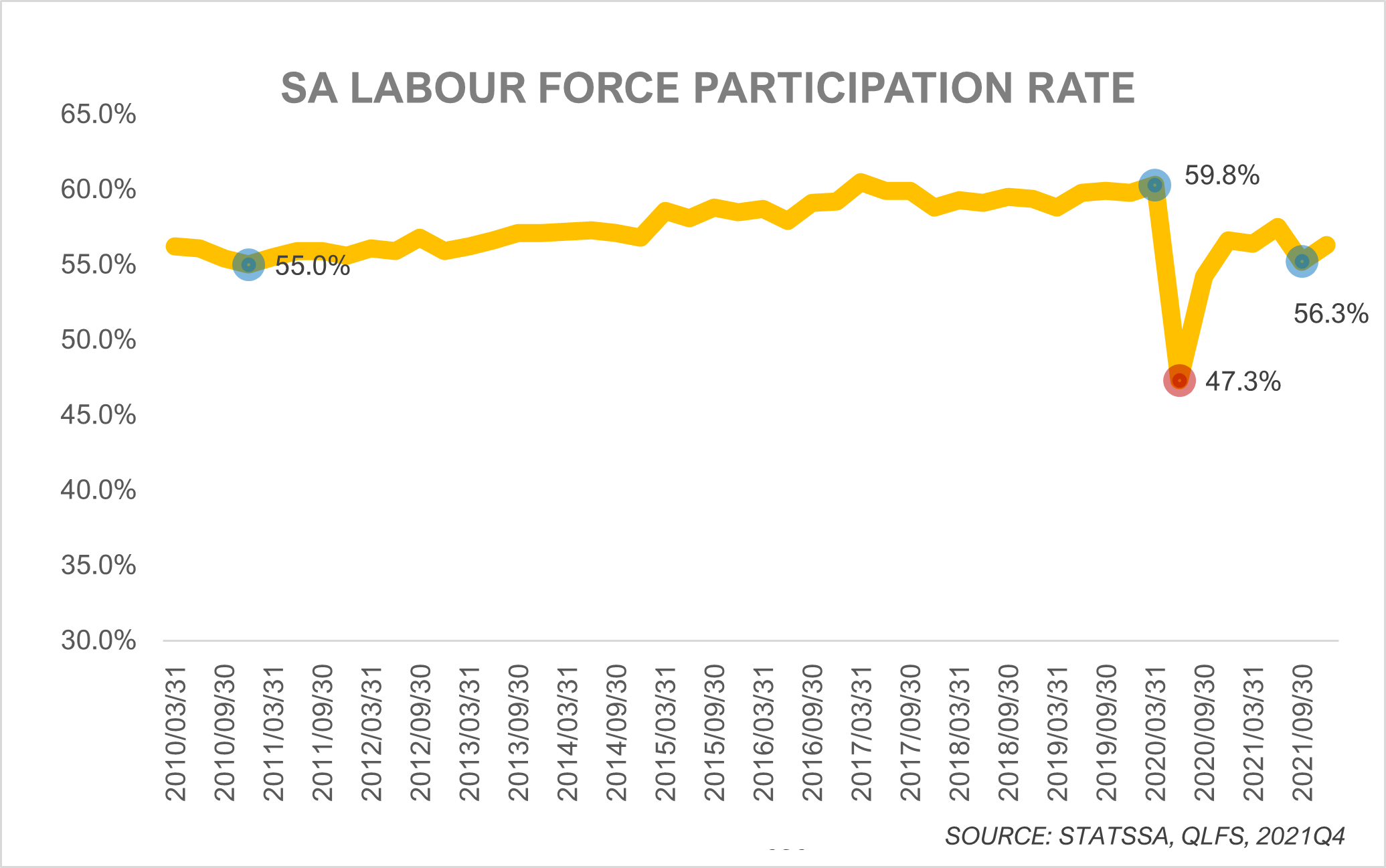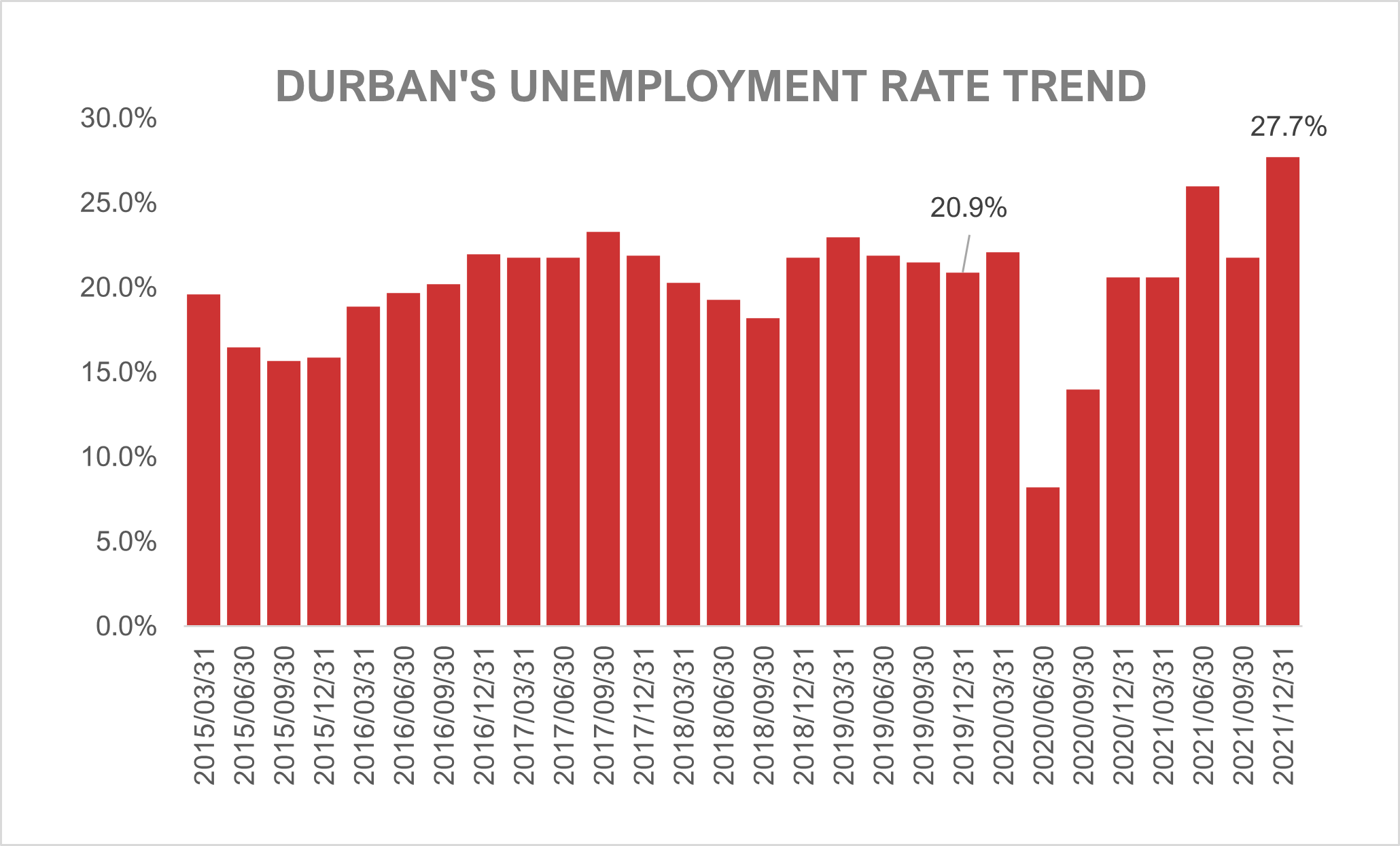
DISCLAIMER: Due to data quality and increasingly low response rates across metros, StatsSA has decided not to officially publish QLFS metro data indefinitely. StatsSA unemployment statistics quoted in this data story for Durban are retrieved from a secondary source, Quantec (2022).
INTRODUCTION
StatsSA's QLFS publication for 2021Q4 reports that South Africa’s official unemployment rate increased to 35,3%, the highest rate since the beginning of the QLFS survey. While there has been minor progress in economic growth, economic recovery in 2021 was sluggish and ultimately limited job opportunities. This is reflected in most local economies like Durban that are struggling to create employment at sufficient levels. This data story will discuss this rising unemployment and how job creation is not keeping up with population growth, resulting in people losing hope of finding work and leaving the labour force. It will also look at the issue of rising unemployment amongst the youth, and finally the state of unemployment in Durban. This datastory primarily focuses on South Africa due to availability challenges of Durban data.

LABOUR FORCE PARTICIPATION PLUMMETS OVER 2 YEAR PERIOD
The labour force participation rate in South Africa decreased to 56,3% from 59,8% in 2019Q4. The working age population increased by 1, 161 million in 2021Q4 from 38, 727 million in 2019Q4. There was a significant shift from the “employed” and “unemployed” to "not economically active" category during this period, resulting in681 000 less people in the labour force. The number of “not economically active” increased by 1, 842 million. 1, 161 million of these people are new entrants to the working aged group and 681 000 are the number of people that exited the labour force, having previously been part of it. Discouraged work seekers increased by 951 172, indicating that more people are struggling to find work and the economy is not creating jobs at a pace that keeps up with population growth.
SA YOUTH UNEMPLOYMENT
The 2021Q4 QLFS release showed that SA youth unemployment is a staggering 66,5% for ages 15 - 24 and 43,5% for ages 25 –34. Only 15% and 26% of youth aged 15 -24 and 25 – 34 are not in education or employment respectively. The youth unemployment rate has gone up by 10,8 of a percentage point on average over 5 years. The increase in youth unemployment in the past 2 years is attributed to Covid-19, July 2021unrest and economic pressures which impacted sales and business services jobs in retail trade and hospitality industry. While businesses and private sector may be be eager on expansion, hiring, and retaining employees, this won’t be easily achievable given the uncertainty around the current economic climate (unreliable energy supply, service delivery and unfavorable business environment). Aside from the discouraging economic performance, thriving digital economies with low barriers to entry as well as the Global Business Service (GBS) sector present opportunities to the unemployed youth.

DURBAN’S UNEMPLOYMENT RATE HITS RECORD HIGH
Durban’s strict unemployment rate increased to 27,7% in the last quarter of 2021. This unemployment rate increased by 6,8 of a percentage point when compared to the last quarter of 2019 (pre Covid-19 levels of unemployment). On average, the number of unemployed people increased by 104 000 between 2019 and 2021. This means the 2021 labour market still falls short of pre Covid-19 levels of employment and 104 000 more people would still need to be employed to get to 1 173 000 (2019 pre Covid-19 levels of employment). The absorption rate in Durban decreased by 5,2 of a percentage point from 47,8% in 2019 to 42,8% in 2021, suggesting that chances of being employed have diminished over this period due to disruption from Covid-19, the July 2021 unrest, and general economic stagnation. This quarter’s decline appears to have reversed the labour market recovery that was seen in 2020Q4 & 2021Q1.
CONCLUSION
This data story concludes that due to rising unemployment and decreased absorption rates, that chances of being employed in the country and in Durban are much less than they were 2 years ago. The working aged population is growing but people are exiting the labour force and gravitating toward the “not economically active” category. This struggling labour market is as a result of sustained economic disruptions, but opportunities in digital economies could potentially accommodate the youth due to low barriers to entry. To rectify the issue of unemployment in the country, more intense effort is needed to fast track employment creation and further build a resilient economy.